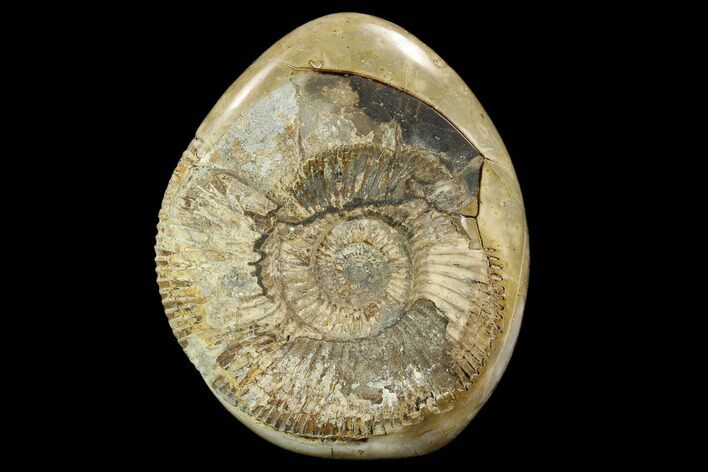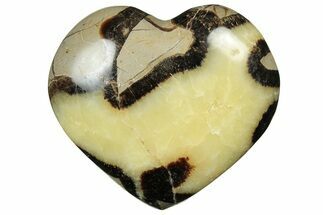This Specimen has been sold.
4.9" Ammonite In Septarian Nodule - Madagascar
This is a 4.9" ammonite (Perisphictes) on Septarian rock, from Betsiboka Region, Madagascar. The ammonite is unpolished while the Septarian is polished.
Ammonites were predatory cephalopod mollusks that resembled squids with spiral shells. They are more closely related to living octopuses, though their shells resemble that of nautilus species. True ammonites appeared in the fossil record about 240 million years ago during the Triassic Period. The last lineages disappeared 65 million years ago at the end of the Cretaceous.
Septarian or septarian nodules are concretions containing angular cavities or cracks, called "septaria", filled with calcite and aragonite. A concretion is a hard, compact mass of rock that often forms around decaying organic matter. In the case of septarian nodules, the concretions formed around decaying sea life in a marine environment.
The exact mechanism for how the cracks form in the concretions is a mystery. One possible mechanism is the dehydration of the clay-rich core of a concretion, causing it to shrink and crack. The cracks could also be caused by gas expansion produced by the decaying organic matter within a concretion. Earthquakes have also been suggested as yet another mechanism.
The cracks in the concretions are then filled in with minerals such as calcite (yellow), aragonite (brown), and sometimes pyrite, causing very interesting patterns. They have often been described as looking like dragon's skin. They are frequently found as geodes with hollow, calcite crystal-filled cavities. More rarely, the fossils that originally started the formation of the concretion are still preserved in the septarian.
The exact mechanism for how the cracks form in the concretions is a mystery. One possible mechanism is the dehydration of the clay-rich core of a concretion, causing it to shrink and crack. The cracks could also be caused by gas expansion produced by the decaying organic matter within a concretion. Earthquakes have also been suggested as yet another mechanism.
The cracks in the concretions are then filled in with minerals such as calcite (yellow), aragonite (brown), and sometimes pyrite, causing very interesting patterns. They have often been described as looking like dragon's skin. They are frequently found as geodes with hollow, calcite crystal-filled cavities. More rarely, the fossils that originally started the formation of the concretion are still preserved in the septarian.
SPECIES
Septarian, Unidentified Ammonite
AGE
LOCATION
Ambondromamy, Betsiboka Region, Madagascar
SIZE
4.9" ammonite, 5.3" tall on Septarian
CATEGORY
ITEM
#124161
 Reviews
Reviews
















